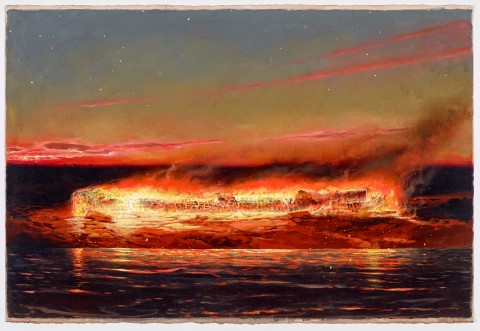THE WATER LINE, 1997
TIM STORRIER
synthetic polymer paint on paper
102.5 x 151.5 cm
signed, dated and inscribed with title lower right: ‘The Water Line’ / Storrier / 1997
Christopher Day Gallery, Sydney (label attached verso)
Private collection, Sydney, acquired from the above in May 1998
Christopher Day Gallery at Antique Dealers Association, Sydney, May 1998
Lumby, C., Tim Storrier: The Art of the Outsider, Craftsman House, Sydney, 2000, pl. 118, p. 164 (illus., dated as 1996)
Klepac, L., Tim Storrier, The Beagle Press, Sydney, 2018, p. 164 (illus., dated as c.1996)
Encompassing the subtlety of nature’s fugitive diurnal moods, its mysterious, silently unfolding rituals and vast droning presence, Tim Storrier’s iconic outback paintings evoke a poignant sense of place that is inextricably Australian. As Edmund Capon, a former director of the Art Gallery of New South Wales elucidates, ‘they could not, I believe have come from any country other than Australia’.1 Typically juxtaposing the element of fire against low horizons and expansive skies, indeed his evocations are indelible echoes of this brooding landmass – long-contemplated narratives inspired by Storrier’s own highly personal experience of the landscape, and enhanced by the alluringly beautiful texture and finish of his art. Utterly individual and exquisitely rendered, thus his interpretations feature among the most instantly recognisable and universally admired images in Australian art.
Upon first glance, The Water Line, 1997 mines familiar territory in Storrier's oeuvre, with the strong horizontal tension of the blazing horizon echoing his celebrated 'point to point' paintings of the 1980s. Yet despite such affinities, the composition reveals a significant shift in Storrier's vision towards the end of the millennium: where previously his evocations of fire had been literal and direct, now his treatment is more subdued, reflective and abstract. The rope too has been replaced by a burning log and the glowing embers of a vacated campsite, thus inviting darker, more sublimated readings which explore concepts of displacement and isolation. As Catharine Lumby suggests in her monograph on the artist, these nocturnal landscapes 'announce a more sophisticated exploration of the emotive, melancholic mood that has always haunted Storrier's work – of the themes of isolation and abandonment which he had focused on explicitly in works like Retreat, 1972, Defence of Indado, 1973, and Death of a Warrior in Spring, 1975. The skies in his nocturnal paintings are an intense cobalt blue, cut back with darker glazes ... the landscape here is at once awe-inspiring and threatening, both enveloping and alienating’.2
Like the finest of Storrier's work, The Water Line encapsulates the artist's enduring interest in the four elements and the power of life which they embody. In the manner of the great Romantic painters of the nineteenth century such as JMW Turner and Caspar David Friedrich, Storrier here contemplates the insignificance of humankind when compared to the awesome magnitude of the natural world, drawing upon the symbolism of the fading light of day as a metaphor for change or the fin de siècle, end of an era. Unifying fire with an entirely different great vastness (untraversed bodies of water and infinite celestial skies), thus the present work may be construed as bearing allusions to evolution, the passing of time and the grandeur of decay in the same vein as the traditional vanitas still life. As Storrier himself muses, ‘there is a relationship between fecundity and mortality, between something that is wet and something that is burning. These are primal poetic qualities that do not change in terms of the human spirit’.3
1. Capon, E., quoted in Lumby, C., Tim Storrier: The Art of the Outsider, Craftsman House, Sydney, 2000, p.8
2. ibid., p.142 – 3
3. The artist quoted in Tim Storrier: The Burning Gifts, Australian Galleries, Melbourne, 1989, p. 11
VERONICA ANGELATOS
